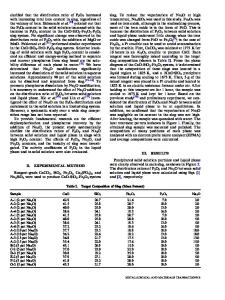Chemical potentials of oxygen for mixtures of CaO (s) + Ca 4 P 2 O 9 (s) + {CaO + P 2 O 5 + Fe x O} melts and Ca 4 P 2 O
- PDF / 313,594 Bytes
- 4 Pages / 612 x 792 pts (letter) Page_size
- 21 Downloads / 324 Views
I.
INTRODUCTION
FIGURE 1 shows the isothermal section of the phase diagram of the system CaO + P205 + FexO at 1673 K based on the work of Tromel et al.t~.'-] Points U and V of Figure I correspond to the liquidus compositions for the three-phase coexistence of CaO (s) + Ca4P20 9 (s) h- liquid and Ca4P20 9 (s) -Jr Ca3PzO 8 (s) 4- liquid, respectively. Hereafter, the following notations are used: C = CaO, C4P = CanP2Og, C3P = Ca3P2Os, and L = ternary liquid slag. During the course of thermodynamic studies on steelmaking slags used for the removal of phosphorous from hot metal, it became necessary to know the chemical potentials of oxygen for these three-phase assemblages. In the present study, an electrochemical technique involving stabilized zirconia was employed for the measurements of equilibrium oxygen partial pressures of the three-phase mixture under consideration. The electrochemical cells used in this study can be expressed as Mo/Mo + MoO2/ZrO2 (MgO)/Fe (s) + C + C4P + L/Ag/Fe or
Mo/Mo + MoO2/ZrO 2 (MgO)/Fe (s) + C4P + C3P + L/Ag/Fe
II.
E X P E R I M E N T A L ASPECTS
The experimental apparatus and procedures have been described elsewhere.t3.4] An iron crucible was charged with about 20 g of a mixture of either C + C4P or CaP + C3P; initially, iron oxide was not present within the iron crucible. The preparation of C4P and C3P was based on a manner described elsewhereY ,6] The iron crucible was heated to the
HIDEAKI HOSHINO, Graduate Student, and MASANORI IWASE, Professor, are with the Department of Energy Science and Engineering, Kyoto University, Kyoto 606, Japan. Manuscript submitted December 31, 1994. METALLURGICAL AND MATERIALS TRANSACTIONS B
experimental temperatures in a stream of purified argon inside a SiC resistance furnace, which was equipped with a mullite reaction tube of 60-mm o.d., 50-mm i.d. and 1000mm length. During this heating, the iron crucible would slightly be oxidized by gaseous oxygen remaining within argon gas resulting in the formation of very small amounts of CaO + P205 4- FexO liquid ternary slags. The electrochemical half cell, Mo/Mo + MoO/ZrO2 (MgO), consisted of a zirconia tube and a two-phase mixture of Mo + MoO 2. A molybdenum rod was used as an electrical contact to the reference electrode, while the electrical contact to the outer electrode of the zirconia probe was made by the liquid silver and a steel rod soldered to the iron crucible. The use of dissimilar electrical connectors required a correction for the thermal-emf of a steel-molybdenum couple.m Experiments were conducted at temperatures between 1573 and 1723 K. The zirconia probes were first inserted into the furnace about 200 mm above the oxide phase, and then gradually moved downward until the probe contacted both the oxide phases and the liquid silver. Stable emfs (_+0.2 to 0.5 mV) were then obtainable for over 20 minutes. Cell potentials generated were measured by a strip chart recorder of 2 M ohm internal impedance with an accuracy of +__0.1 mV, and more accurately read by a digital voltmeter of 100 M ohm
Data Loading...











